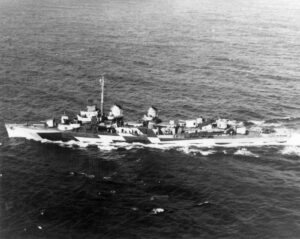During World War II, millions of young Americans enlisted or were drafted into the United States Navy to man the largest fleet ever created. Hailing from Lancaster County, Pennsylvania, Donald R. Witmer would take part in this experience. Having a technical background, Witmer was rated as a torpedoman and was eventually assigned to USS Twiggs (DD 591), a Fletcher class destroyer.
Commissioned on 4 November 1943, Twiggs would join the Pacific Fleet in 1944 to participate in the Leyte, Luzon, Iwo Jima, and Okinawa invasions. Off Okinawa, Twiggs would be struck twice by kamikazes. The second strike proved fatal. On 16 June 1945, at 2030, a single, low-flying plane dropped a torpedo, which hit Twiggs on her port side, exploding in her number two magazine. The plane then circled and completed its mission with a suicide crash. Enveloped in flames, the Twiggs would sink an hour later. There were 152 sailors, including the skipper, Commander George Phillip, killed. Injured with burns and a broken leg, Witmer was amongst 188 survivors.
Witmer wrote down his recollections of the attack for a Twiggs reunion. That vivid recollection has been added as an appendix to this interview.
Robert F. Naczi, a retired chemical engineer from Wilmington, Delaware, conducted the interview on 7 March 1998 on behalf of the Naval Historical Foundation’s oral history outreach program. Although not a historian by trade, Naczi has had a long interest in naval history. In 1995, the U.S. Naval Institute Proceedings published his article “Tragedy Strikes in New York Harbor: The Sinking of USS Turner, DD 648.” He prepared well for the interview, studying the ship’s history and other materials on the war in the Pacific. In addition, he assisted, along with Witmer, in editing the transcript, insuring correct dates and place names.
The Naval Historical Foundation is grateful for the efforts of these two men to help capture this deckplate perspective of World War II combat.


